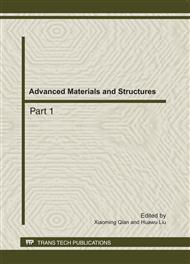[1]
D.E. Fenton, J.M. Parker, P.V. Wright, Complexes of alkali metal ions with poly(ethylene oxide), Polymer 14(11) (1973) 589.
DOI: 10.1016/0032-3861(73)90146-8
Google Scholar
[2]
F.M. Gray, Polymer Electrolytes, The Royal Society of Chemistry, UK, 1997.
Google Scholar
[3]
C.P. Fonseca, S. Neves, Characterization of polymer electrolytes based on poly(dimethyl siloxane-co-ethylene oxide), J. Power Sources 104 (2002) 85-89.
DOI: 10.1016/s0378-7753(01)00902-8
Google Scholar
[4]
S. Rajendran, O. Mahendran, R. Kannan, Lithium ion conduction in plasticized PMMA-PVdF polymer blend electrolytes, Materials Chemistry and Physics 74 (2002) 52-57.
DOI: 10.1016/s0254-0584(01)00400-x
Google Scholar
[5]
F. Yuan, H.Z. Chen, H.Y. Yang, H.Y. Li, M. Wang, PAN-PEO solid polymer electrolytes with high ionic conductivity, Materials Chemistry and Physics 89 (2005) 390-394.
DOI: 10.1016/j.matchemphys.2004.09.032
Google Scholar
[6]
G.A. Nazri, S.G. Meibuhr, Effect of γ-radiation on the structure and ionic conductivity of 2-(-2-methoxy-ethoxy-ethoxy)polyphosphazane + LiCF3SO3, J. Electrochem. Soc. 136 (1989) 2450-2454.
DOI: 10.1149/1.2097423
Google Scholar
[7]
Z. Uchimoto, Z. Ogumi, F.R. Takehara, J. Foulkes, Ionically conductive thin polymer films prepared by plasma polymerization, J. Electrochem. Soc. 137 (1990) 35-40.
DOI: 10.1149/1.2086429
Google Scholar
[8]
N. Kobayashi, N. Kubo, R. Hirohashi, Control of ionic conductivity in solid polymer electrolyte by photo irradiation, Electrochim. Acta 37 (1992) 1515-1516.
DOI: 10.1016/0013-4686(92)80101-q
Google Scholar
[9]
L. Fan, Z. Dang, C.W. Nan, M. Li, Thermal, electrical and mechanical properties of plasticized polymer electrolytes based on PEO/P(VDF-HFP) blends, Electrochim. Acta 48 (2002) 205-209.
DOI: 10.1016/s0013-4686(02)00603-5
Google Scholar
[10]
J.E. Weston, B.C.H. Steele, Effects of inert fillers on the mechanical and electrochemical properties of lithium salt-poly(ethylene oxide) polymer electrolytes, Solid State Ionics 7 (1987) 75-79.
DOI: 10.1016/0167-2738(82)90072-8
Google Scholar
[11]
B. Kumar, L.G. Scanlon, R.J. Spry, On the origin of conductivity enhancement in polymer-ceramic composite electrolytes, J. Power Sources 96 (2001) 337-342.
DOI: 10.1016/s0378-7753(00)00665-0
Google Scholar
[12]
P.A.R.D. Jayathilaka, M.A.K.L. Dissanayake, I. Albinson, B.E. Mellander, Effect of nano-porous Al2O3 on thermal, dielectric and transport properties of the (PEO)9LiTFSI polymer electrolyte system, Electrochim. Acta 47 (2002) 3257-3268.
DOI: 10.1016/s0013-4686(02)00243-8
Google Scholar
[13]
F. Croce, L. Persi, B. Scrosati, F. Serraino-Fiory, E. Plichta, M.A. Hendrickson, Role of ceramic fillers in enhancing the transport of composite polymer electrolytes, Electrochim. Acta 46 (2001) 2457-2461.
DOI: 10.1016/s0013-4686(01)00458-3
Google Scholar
[14]
G. Gnana Kumar, Pil kim, Ae rhan kim, Kee suk Nahm, R. Nimma Elizabeth, Structural, thermal and ion transport studies of different particle size nanocomposite fillers incorporated PVdF-HFP hybrid membranes, Materials Chemistry and Physics 115 (2009) 40-46.
DOI: 10.1016/j.matchemphys.2008.11.023
Google Scholar
[15]
Vanchiappan Aravindan, P. Vickraman, Lithium fluoroalkylphosphate based novel composite polymer electrolytes (NCPE) incorporated with nanosized SiO2 filler, Materials Chemistry and Physics 115 (2009) 251-257.
DOI: 10.1016/j.matchemphys.2008.11.062
Google Scholar
[16]
Tan Winie, A.K. Arof, FT-IR studies on interactions among components in hexanoyl chitosan-based polymer electrolytes, Spectrochim. Acta A 63 (2006) 677-684.
DOI: 10.1016/j.saa.2005.06.018
Google Scholar
[17]
F.H. Muhammad, R.H.Y. Subban, Tan Winie, Electrical Studies on Hexanoyl Chitosan-based Nanocomposite Polymer Electrolytes, AIP Conference Proceedings 1136 (2009) 61-65.
DOI: 10.1063/1.3160219
Google Scholar
[18]
M.J. Rice, W.L. Roth, Ionic transport in super ionic conductors: a theoretical model, J. Solid State Chemistry 4 (1972) 294-310.
DOI: 10.1016/0022-4596(72)90121-1
Google Scholar
[19]
G.C. Psarras, E. Manolakaki, G.M. Tsangaris, Dielectric dispersion and ac conductivity in-Iron particles loaded-polymer composites, Composites Part A 34 (2003) 1187-1198.
DOI: 10.1016/j.compositesa.2003.08.002
Google Scholar
[20]
R. Murugaraj, G. Govindaraj, D. George, Ac conductivity and its scaling behavior in lithium and sodium bismuthate glasses, Materials Letters 57 (2003) 1656-1661.
DOI: 10.1016/s0167-577x(02)01047-9
Google Scholar
[21]
Z. Zong, Y. Kimura, Takahashi, M.H. Yamane, Characterization of chemical and solid state structures of acylated chitosans, Polymer 41 (2000) 899-906.
DOI: 10.1016/s0032-3861(99)00270-0
Google Scholar
[22]
R. Mishra, K.J. Rao, Electrical conductivity studies of poly(ethyleneoxide)-poly(vinylalcohol) blends, Solid State Ionics 106 (1998) 113-127.
DOI: 10.1016/s0167-2738(97)00493-1
Google Scholar
[23]
M. Siekierski, W. Wieczorek, J. Przyluski, AC conductivity studies of composite polymeric electrolytes, Electrochim. Acta 43 (10-11) (1998) 1339-1342.
DOI: 10.1016/s0013-4686(97)10040-8
Google Scholar
[24]
R. Ondo-Ndong, G. Ferblantier, F. Pascal-Delannoy, A. Boyer, A. Foucaran, Electrical properties of zinc oxide sputtered thin films, Microelectronics J. 34 (2003) 1087-1092.
DOI: 10.1016/s0026-2692(03)00198-8
Google Scholar
[25]
F.H. Abd El-kader, W.H. Osman, K.H. Mahmoud, M.A.F. Basha, Dielectric investigations and ac conductivity of polyvinyl alcohol films doped with europium and terbium chloride, Physica B 403 (2008) 3473-3484.
DOI: 10.1016/j.physb.2008.05.009
Google Scholar
[26]
A.E. Bekheet, N.A. Hegab, Ac conductivity and dielectric properties of Ge20Se75In5 films, Vacuum 83 (2009) 391-396.
DOI: 10.1016/j.vacuum.2008.05.023
Google Scholar
[27]
Lobna M. Sharaf El.Deen, The ac conductivity studies for Cu2O-Bi2O3 glassy system, Materials Chemistry and Physics 65 (2000) 275-281.
DOI: 10.1016/s0254-0584(00)00244-3
Google Scholar
[28]
J.M. Stevels, The electrical properties of glass, Hantbuch der physic (1957) 350-391.
Google Scholar
[29]
S. Ebrahim, A.H. Kashyout, M. Soliman, Ac and Dc conductivities of polyaniline/poly vinyl formal blen films, Current Applied Physics 9 (2009) 448-454.
DOI: 10.1016/j.cap.2008.04.007
Google Scholar
[30]
C. Fanggao, G.A. Saunders, E.F. Lambson, R.N. Hampton, G. Carini, G. Di Marco, M. Lanza, Temperature and frequency dependencies of the complex dielectric constant of poly(ethylene oxide) under hydrostatic pressure, J. Polymer Science: Part B: Polymer Physics 34 (1996) 425-433.
DOI: 10.1002/(sici)1099-0488(199602)34:3<425::aid-polb3>3.0.co;2-s
Google Scholar
[31]
M.M. El-Nahass, A.M. Farid, K.F. Abd El-Rahman, H.A.M. Ali, Ac conductivity and dielectric properties of bulk tin phthalocyanine dichloride (SnPcCl2), Physica B 403 (2008) 2331-2337.
DOI: 10.1016/j.physb.2007.12.015
Google Scholar
[32]
Tan Winie, A.K. Arof, Dielectric behaviour and ac conductivity of LiCF3SO3 doped H-chitosan polymer films, Ionics 10 (2004) 193-199.
DOI: 10.1007/bf02382816
Google Scholar


